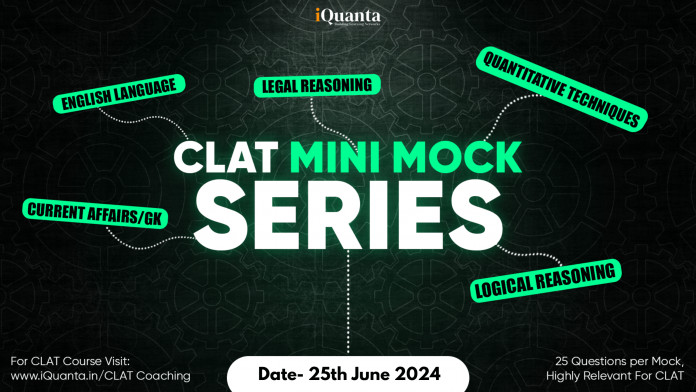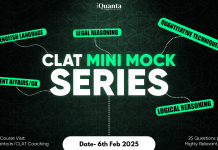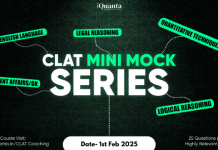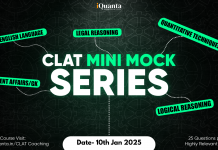iQuanta has launched a Mini Mock Series covering all the sections of the CLAT exam, these questions have been handpicked by our faculty based on the latest CLAT exam pattern.
Instructions:-
1. Attempt all the questions.
2. Once you have completed all the questions of a particular section click on the submit button for scores and explanations then move to the next sections.
3. For each correct answer, you receive 1 mark. For this mock, there is no negative marking.
English Language
Directions: Read the passage and answer the following question.
Kolkata had been a sleepy village right up to the point us Brits showed up and decided it was the perfect place to start an empire. In its Victorian heyday, it was a thriving port, where fortunes could be made, and immigrants flocked from all over the world in search of work and a better life. To avoid any cultural ‘unpleasantness’, the British devised a system whereby they divided the city according to colour. There was the ‘White Town’, made up of European (mainly British) settlers, which looked a little like Kensington, with its stucco buildings and wide boulevards. There was the ‘Black Town’, where the Indians lived. And then there was the ‘Grey Area’ where everyone else got put. It’s now called Bowbazar, and remains a wonderful, jumbled mish-mash of nationalities and ethnicities.
Bowbazar is both chaotic and harmonious, fractious and tolerant. This tight-knit mix, where everyone eats, shops and works together, may well account for the fact that when Prime Minister Indira Gandhi was shot by her bodyguards thirty years ago Kolkata was the only place in India that didn’t see reprisals against the Sikh community.
To walk around the district of Bowbazar is to tour the world: there are churches and synagogues, minarets and stupas. One moment you’re in a classic Indian street, commuters savouring their clay cups of sweet chai, then you’re in Parsee territory, walking past the Zoroastrian temple, where a sacred flame has burnt since 1912. There’s a wedding cake of an Armenian church, a baby-pink Jain temple and a red and cream coloured synagogue, built in Kolkata’s Raj heyday, when the city had a population of some ten thousand Jews. Today there are fewer than thirty, barely enough for a service. There is no rabbi to light the Shabbat lamps, so this sacred duty is carried out by a Muslim family.
We wander further. The imam calls the faithful to prayer. Ten thousand men fill the streets, get down on their knees and stop the traffic. Moments later, they get up, and the bustle begins again.
We enter the Nakhoda Masjid Mosque and the temperature drops. I welcome the sudden cool. I remove my boots and sit them next to the hundred or so dusty sandals that crown the entranceway. My hot feet spread on the chilled tiles. There are dozens of men lounging by the Ablution Pool, and others lie fast asleep on their backs, snoring, in the shade of the main courtyard.
A girl approaches, drawn to the spectacle of a television crew. She says in perfect English that she wants to be a journalist. I don’t want to tell her this, but with two fluent languages and a can-do attitude, she is already over-qualified.
[Excerpted from East of Croydon by Sue Perkins published by Penguin Random House, UK]
Current Affairs and General Knowledge
Directions: Read the passage and answer the following question.
In a significant strategic development, the Reserve Bank of India (RBI) has recently moved over 100 tonnes of gold from the UK to its domestic vaults. This marks the first time since a long that such a substantial quantity of gold has been repatriated to India. This move, driven by logistical consideration and a desire for diversified storage, highlights the RBI’s evolving approach to managing its gold reserves. As central banks globally increase their gold holding amid economic uncertainties, the RBI’s actions reflect a broader trend and signal confidence in India’s economic stability.
The RBI moved 100 metric tonnes of its gold stored in the UK to domestic vaults in FY24. This is one of the biggest movements of gold undertaken by the country since 1990s, when pledging a substantial part of the gold holding to tide over a foreign exchange crises resulted in movement in vaults.
Legal Reasoning
Directions: Read the passage and answer the following question.
The word ‘ostensible’ means ‘something that appears to be true’. The ostensible owner is thus not the real owner of a property. He merely represents himself as real owner to the third parties. Such ostensible owner possesses all the rights of ownership in a property without being the real owner of it. He acquires these rights from the real owner by the express or implied consent of such an owner. He is the full and unqualified owner and the real owner is the qualified owner of the property.
The following persons cannot be considered ostensible owners: professed agents, trustee, servants, guardians or any other person acting under fiduciary character, and they will obtain real ownership.
The doctrine of transfer of property by ostensible owner is an exception to the maxim ‘nemodat quod non habet’, which means no one can confer a higher right on the property that he himself possesses. Section 41 protects the innocent parties from the fraudulent acts of the third party. The loss arising from such an act shall fall on the person who created or failed to prevent the fraud.
Section 41 of the Transfer of Property Act lays down that when a person acts on the express or implied consent of a person who is interested in an immovable property, the person who acts on such consent is the ostensible owner of the property. He possesses all the indicia of ownership like the right to title, possession, documents. etc. He can transfer the property for consideration to the transferee. The transferee must act in good faith and believe that the ostensible owner is the real owner of the property. The real owner who allows the other to hold himself out cannot be allowed to recover from his secret title. Hence, the transfer is not voidable on the ground that the ostensible owner was not authorised to execute a transfer.
Benami transactions are an example of transfer by an ostensible owner. In case of such transactions, the burden of proof lies on the person who claims to be the real owner of the property. However, surrounding facts and circumstances such as the intention of the parties, conduct, source of purchase, etc. shall also be considered for ascertaining the burden of proof.
[Extracted with edits and revisions from ‘Ostensible Owner’, www.lawtimesjournal.in]
Logical Reasoning
Directions: Read the passage and answer the following question.
A groundbreaking robotic innovation has emerged from a college campus, where a wheeled automaton has mastered the art of opening a myriad of doors and drawers, navigating the real world with unprecedented autonomy. This robot, developed by researchers including Deepak Pathak at Carnegie Mellon University, showcases the potential for machines to independently interact with a diverse range of physical objects, a significant leap towards autonomous robotic assistance.
The robot’s learning process began with imitation learning, where it was shown how to manipulate objects such as doors, cabinets, drawers, and refrigerators. Subsequently, it was set free on the campus to tackle previously unseen challenges, relying on artificial intelligence to adapt and learn from each new encounter. Remarkably, the robot required only 30 minutes to an hour to learn how to consistently open each new object, demonstrating a significant advancement in robotic learning efficiency.
Despite initial success rates hovering around 50 percent, the robot’s performance dramatically improved over time, eventually achieving a success rate of approximately 95 percent. This improvement underscores the robot’s ability to learn and adapt in real-time, a critical capability for autonomous operation in varied environments.
The project, which cost $25,000, represents a cost-effective solution in the realm of adaptive learning robotic systems. According to Russell Mendonca of Carnegie Mellon University, this investment has paved the way for more generalized robotic manipulation systems, capable of performing tasks that are deceptively simple for humans but historically challenging for robots, such as opening doors and drawers.
This innovation marks a significant step forward in the development of robots capable of performing complex tasks independently, heralding a future where robotic assistants could become an integral part of everyday life, seamlessly interacting with the physical world around them.
Quantitative Techniques
Directions (1-5): Study the following information carefully and answer the question given below:
Pie chart shows the production of rice by 5 different factories and line chart shows the percentage of sale.






